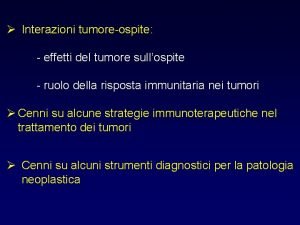Carcino Cerv Prof Parul J Head Dept of











































- Slides: 43

Carcino Cerv Prof. Parul J Head, Dept. of Ob Medical College for Wo

Introduction • Cervical cancer is the fourth most common women worldwide. • Cervical cancer is a disease that develops quite begins with a precancerous condition known as • CIN is easily detected in a routine Pap sm completely treatable. • Cervical cancer is a malignant tumour deriving

Epidemiology • Approximately 570 000 cases of cervical cancer deaths from the disease occurred in 2018. • The estimated age-standardized incidence of cer was 13· 1 per 100 000 women globally and v among countries, with rates ranging from less tha 100000 women. • Cervical cancer was the leading cause of cancer-

A Leading Cause of Dea Bangladesh

What is cervical Cancer that starts in cancer? the cervix – the lower p uterus (womb) that connects to the vagina (b • Two cell types: squamous and glandular • Cervical cancer tends to

Etiology Human Papilloma Virus (HPV) • HPV is epitheliotropic and plays an importan development of CIN. • HPV infected cells (koilocytes) are characterize cells with perinuclear halos. • The nucleus is large, irregular and hyperchromat

Sexual History A woman has a higher-than-average risk of d cervical if she • Has had multiple sexual partners. • Began having sexual relations before the age of

Risk Factors • Smoking • Weakened immune system • Several pregnancies • Giving birth at a very young age

Gross Pathology The site of the lesion is predominantly ectocervix (80%) and the rest (20%) are in th • Naked Eye Ø Exophytic Ø Ulcerative • Histo. Pathology Ø Squamous ce



Mode of Spread • Direct extension • Lymphatic • Hematogenous

Patterns of Spread

Assessment & Diagno finding PAP test Routine screening for cervical abnormalities can detect earlystage cancer and precancerous conditions that could progress to invasive disease. The process


HPV DNA test Like the Pap test, the HPV DNA test involves col from the cervix for lab testing.

Colposcopy

Cone Biopsy

Chest X-Ray

Others • CT (computerized tomography) sc • MRI (magnetic resonance imaging • Pelvic ultrasound

Staging • Staging of cervical cancer is based princip examination. • Pelvic examination (speculum, bimanual examination) should be done under anesthesia. • The routine supplementary investigations inclu intravenous pyelography, cystoscopy and procto • CT scan, MRI, Positron Emission Tom

Revised FIGO staging for carcinom cervix uteri

Revised FIGO staging for carcinom cervix uteri


• • • Patient’s Profile Irregular or continued vaginal bleeding. Postcoital bleeding. Offensive vaginal discharge. Pelvic pain of varying degree Leg edema is due to progressive obstruction o and/or iliofemoral veins by the tumor. • Bladder symptoms include frequency of micturi

Cont… • Ureteral obstruction is due to progressive growth of • Ultimately, the patient may be cachectic, anemic w Ultimately uremia develops.

• SIGNS • ON PERSPECULUM EXAMINATION. . • When an obvious growth is present it may be • Exophytic coliflowerlike or endophytic, ulcerative. • ON BIMANUAL EXAMINATION(CARDINAL FEATURES) • Hard • Fixed

For confirmation of diagnosis, B mandatory Differential diagnosis v Cervical tuberculosis v Syphilitic ulcer v Cervical ectopy v Products of conception in incomplete

Complications v Hemorrhage. v Frequent attacks of ureteric pain, due to py pyelonephritis and hydronephrosis. v Pyometra — specially with endocervical varie v Vesicovaginal fistula.

Management of Carci Cervix Preventive v Primary Prevention§ § § Identifying ‘high-risk’ female Women with high risk HPV infecti Early sexual intercourse Early age of first pregnancy Too many births/too frequent birth.

Cont… v Identifying ‘high-risk’ males§ Multiple sexual partners. § Previous wife died of cervical carcinoma v Prophylactic HPV vaccine(cervarix and Gardasil) v Use of condom during early intercourse, raising the and of first birth, limitation of family, maintenance and effective therapy of STIs are the positive steps in

Curative v Ideally, the management of the patient with cervical team approach. Both the gynecologist and radio should review the patient. v Due consideration should be given to: Ø General condition of the patient. Ø Stage of the disease. Ø Facilities available- surgical and radiothera

Pretreatment Preparations v Irrespective of the methods of treatment, gener the patient must be improved. Due attention is t correct anemia and malnutrition. v This not only makes the patient sufficiently fit t surgery but rise in hemoglobin percentage im

The types of treatment employed invasive carcinoma are as foll ü Primary surgery ü Primary radiotherapy ü Chemotherapy








What can be done Get screen This is a well-proven way to prevent cervical cancer and

 Dfmcr in pregnancy
Dfmcr in pregnancy Ag carcino embrionale cea
Ag carcino embrionale cea Tac estadiaje cerv-tor-abd-pel
Tac estadiaje cerv-tor-abd-pel Parul polytechnic institute
Parul polytechnic institute Ca un stalp eu stam in luna
Ca un stalp eu stam in luna Condyles of femur
Condyles of femur Indexing head parts
Indexing head parts Shins body
Shins body Pre-head head tonic syllable tail
Pre-head head tonic syllable tail The attacking firm goes head-to-head with its competitor.
The attacking firm goes head-to-head with its competitor. What is a tonic syllable
What is a tonic syllable Moving head disk mechanism
Moving head disk mechanism Informtika
Informtika Flooded suction pump
Flooded suction pump Disk
Disk Maine department of agriculture conservation and forestry
Maine department of agriculture conservation and forestry Gome dept
Gome dept Dept. name of organization (of affiliation)
Dept. name of organization (of affiliation) Dept nmr spectroscopy
Dept nmr spectroscopy Nebraska dept of agriculture
Nebraska dept of agriculture Affiliate disclodures
Affiliate disclodures Dept a
Dept a Gome dept
Gome dept Dept. name of organization (of affiliation)
Dept. name of organization (of affiliation) Tabella nmr
Tabella nmr Dept of education
Dept of education Employment first ohio
Employment first ohio Florida department of agriculture and consumer services
Florida department of agriculture and consumer services Iit
Iit Geaux biz login
Geaux biz login Central islip fire department
Central islip fire department Gome dept
Gome dept Hoe dept
Hoe dept Mn dept of education
Mn dept of education Pt dept logistik
Pt dept logistik Florida dept of agriculture and consumer services
Florida dept of agriculture and consumer services Poster affiliation
Poster affiliation Finance dept structure
Finance dept structure Dept ind onegov
Dept ind onegov Rowan county dss child protective services
Rowan county dss child protective services Gome dept
Gome dept Lafd interview questions
Lafd interview questions Ms department of finance and administration
Ms department of finance and administration Nys dept of homeland security
Nys dept of homeland security



































































